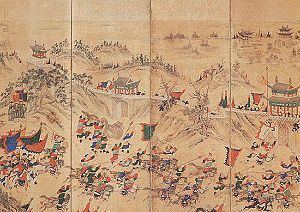Start date 1592 | ||
 | ||
18,700 June 4,000July 6,000August 20,000 June unknown July unknownAugust 100 killed June unknown July 300+ killedAugust 300 killed, 450 wounded Similar Japanese invasions of Korea, Battle of Byeokjegwan, Battle of Noryang, Siege of Busanjin, Siege of Ulsan | ||
The Siege of Pyongyang was part of the Japanese invasions of Korea. Konishi Yukinaga, a Japanese daimyo, captured Pyongyang and garrisoned his force in the winter of 1592. A small detachment of 3,000 Ming soldiers arrived from one of the Manchurian commanderies to investigate the scale of the Japanese invasion after King Seonjo pleaded for aid from the Ming court. The Chinese force was a renowned mounted unit with much experience and success fighting the Jurchens.
However, Konishi was already prepared. As the Chinese entered into a seemingly empty Pyongyang, the Japanese ambushed them with arquebus fire and close-quarter combat. The Chinese troop suffered a loss of 300 men and retreated from Pyongyang but the appearance of Ming troops caused apprehension amongst the Japanese, who feared a larger force was approaching. The Japanese garrison spent the winter of 1592–1593 in isolation and did not venture from the city for fear of encountering Chinese troops without reinforcements and supply.
The Chinese relief force finally arrived in early 1593 under experienced brothers, Generals Li Rusong and Li Rubo, with 45,000 men who besieged the Japanese with artillery and eventually rescued Pyongyang and drove the Japanese south.
